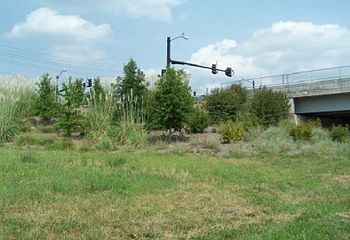120.6 Roadsides

120.6.1 Mowing and Turf Conditions
| Mowing Practices and Fleet Size |
| Summary 2009 |
| Summary 2009 |
| See also: Innovation Library |
Performance Expectation
Vegetation height should be maintained between 6 and 12 inches in fully developed areas and between 6 and 18 inches in undeveloped areas. Slopes greater than 1V:3H (3:1) shall not be mowed unless in urban areas with the proper equipment. Transitions between areas shall be gradual and natural. Chemical and/or mechanical trimming should be done as needed so that vegetation height around signposts, delineators, guardrail, guard cable, etc. is consistent with the mowing height.
Performance Measures
Visual inspections will be conducted on randomly selected tenth-mile segments in the fall to determine if the right of way is being maintained in accordance with the vegetation management policy.
Performance Objectives
Vegetation control may be completed up to at least 30 ft. from the edge of the nearest traveled way with 90% of the areas around objects trimmed or sprayed. 95% of unpaved areas should have proper vegetative cover, not including rock cuts or fill areas constructed predominately of rock. 100% of the right of way should be clear or treated to control noxious weed growth.
 |
 |
120.6.2 Trees and Brush
Performance Expectation
Roadside vegetation shall be maintained to provide a safe clear zone, adequate sight distance and visibility of roadside marking and delineation.
Performance Measures
Visual inspections will be conducted on randomly selected tenth-mile segments in the spring to determine the extent of the encroachments of trees and brush within the clear zone.
Performance Objectives
No tree with a diameter greater than 4 in. at breast height or hardscape shall be within the clear zone as defined in EPG 231.2, unless shielded by guardrail. All of the right of way shall be free of hazardous, leaning, or dead trees capable of falling onto the roadway. All signs shall be visible for a distance of 500 ft. on the mainline and 250 ft. on the ramps.
 |
 |
120.6.3 Debris and Road Kill
Performance Expectation
Debris and road kill shall be removed from the roadway, shoulders and roadsides to provide a safe road and an attractive roadside. It shall be removed as soon as possible if located on the roadway or a ramp. Debris on the shoulders and within the clear zone shall be removed within 48 hours of notification.
Performance Measures
Visual inspections will be conducted on randomly selected tenth-mile segments in the spring and fall to determine number of pieces of debris or road kill present.
Performance Objectives
No findings of debris or road kill within the clear zone.
 |
 |
120.6.4 Litter
Performance Expectation
Litter should be removed from the roadway, shoulders and roadsides in order to provide an attractive roadside. Visible litter should be removed prior to each mowing cycle.
Performance Measures
Visual inspections will be conducted on randomly selected tenth-mile segments in the spring and fall to determine the amount of litter present.
Performance Objectives
The total amount of litter or debris shall not exceed one five-gallon bucket.
 |
 |
120.6.5 Landscape Beds
Performance Expectation
Landscape beds should have a neat and well-maintained appearance overall. Vegetation should be healthy and attractive and not pose a safety concern. Maintenance by other organizations is preferred and encouraged.
Performance Measures
Visual inspections will be conducted on randomly selected interchanges in the fall to determine if the landscape beds look good and are not creating a safety hazard.
Performance Objectives
80% of the vegetation is healthy, well maintained and does not pose a safety hazard.
 |
 |